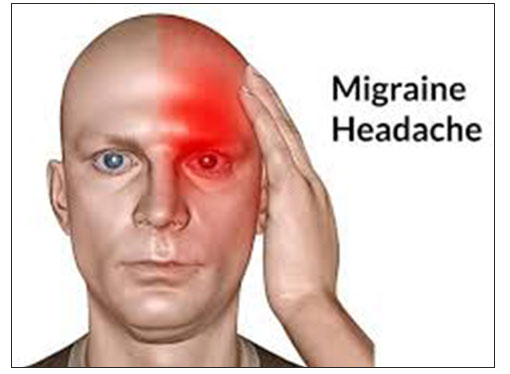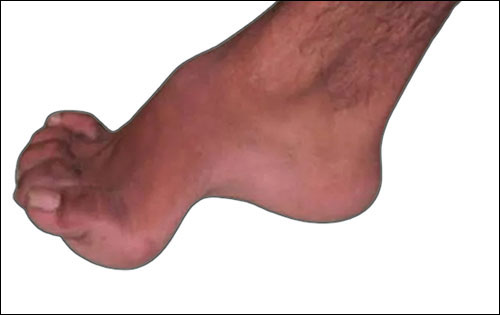Natural Treatment for Migraine with herbal remedies
Abstract
Due to rising urbanisation, people’s way of life has altered in modern times. Stress is creating an increase in the frequency of both acute and chronic diseases as a result of altered work expectations for a better quality of life. One of the chronic illnesses that affects a large portion of the population and has a range of severity is migraine. A multitude of autonomic nervous system symptoms that interfere with daily life, including recurrent mild to severe headaches, describe this chronic neurological condition. There are numerous varieties of Shiro Rogas (head diseases) reported by Acharyas in Ayurvedic scriptures. The clinical characteristics of Ardhavabhedaka, among them, are strikingly similar to those of migraine. Millions of people suffer from the neurological pain disease known as migraine. It is the most prevalent neurological condition that significantly affects the brain and, as a result, the behaviours linked to recurrent migraine attacks. Premigraine, intermigraine, and post migraine processes are connected to migraine stress. Understanding migraine requires knowing how typically painless stimuli like light can make it worse and how a migraine headache can change how sensitive skin is (allodynia), which can affect the entire body. Advanced imaging methods have provided fresh insights into the disease’s causes by revealing changes in the brain’s structure and function. In addition to migraines with and without aura, childhood periodic syndromes, retinal migraine, consequences of migraine, and probable migraine, migraine headaches are a broad collection of illnesses.

Introduction
A migraine is described as “an episodic headache associated with certain features, such as sensitivity to light, sound, or movement” or “a recurring syndrome of headache associated with other symptoms of neurologic dysfunction in varying admixtures”. Resistant migraines (defined as having tried at least three classes of preventatives and experiencing at least eight days of incapacitating headaches per month for at least three months without improvement) and refractory migraines (defined as having tried every preventative method and experiencing at least eight days of incapacitating headaches per month for at least six months) are the two types of migraines. Additionally, various syndromes that have variable clinical manifestations, durations, and prevalence, such as somnambulism, cyclic vomiting, abdominal migraine, benign paroxysmal vertigo, benign paroxysmal torticollis, and confusional migraine, can be connected to migraines. The premonitory phase, brief neurological symptoms (i.e., migraine aura), severe headache attack, and postdrome phase are some of the phases of the cyclical condition known as migraine. Additionally, migraine is a debilitating condition that affects a person’s ability to work, engage in academic and social activities, as well as their family and personal connections.
Types
There are two primary forms of migraine
- A migraine without an aura is characterised by recurrent headache attacks that last 4 to 72 hours, are unilateral in location, have a pulsating character, are moderate to severe in severity, are aggravated by physical activity, are accompanied by nausea, and are sensitive to light and sound (photophobia and phonophobia).
- Attacks of migraine with aura that are recurrent and entirely reversible frequently involve one or more of the unilateral symptoms of vision, hearing, speech, motor function, brainstem, and retina. Other migraine symptoms including headaches are commonly present as well.
- A chronic migraine is a headache that lasts longer than three months and has at least eight days with symptoms resembling a migraine.
Causes And Triggers
- Sudden changes in weather or environment
- Too much or not enough sleep
- Strong odors or fumes
- Emotional Stress Overexertion
- Loud or sudden noises
- Motion sickness
- Low blood sugar
- Skipped meals
- Tobacco
- Depression
- Anxiety
- Head trauma
- Hangover
- Some medications
- Hormonal changes
- Bright or flashing lights
Symptoms
- The most common side of the head is frequently affected by sudden, sharp headache pain
- Other symptoms include nausea, confusion, impaired vision, mood swings, exhaustion, and heightened sensitivity to light, sound, and commotion
Complications
- A crippling migraine attack known as status migrainosus lasts longer than 72 hours.
- An aura that lasts longer than a week without showing signs of infarction on neuroimaging is referred to as a persistent aura without infarction.
- One or more of the aura symptoms that are linked to brain ischemia on neuroimaging during a typical migraine episode is known as migrainous infarction.
- An attack of migraine with an aura can cause a seizure, which is known as a migraine aura-triggered seizure.
Management
- The goal of migraine treatment is to lessen symptoms and prevent new attacks. There are expedient treatments for symptoms, including
- Putting your eyes closed and finding a calm, dark area to sleep
- Applying a cool cloth or an ice pack to the forehead
- Consuming lots of drinks, especially if your migraine is causing you to vomit
- Small doses of caffeine may help ease migraine symptoms in the early stages
- Acute and preventative pharmacological therapies are available for migraines. Acute or “abortive” medications are administered as soon as symptoms start to show in order to alleviate pain and restore function. Preventive treatment aims to minimise the severity of impending attacks or stop them altogether.
Ayurvedic View
It is correlated with Ardhavbhedak in Ayurveda. Ardhavabhedaka is one of the Shiroroga (head disorders) that has symptoms similar to migraine, including paroxysmal unilateral (half cranial) headaches that can occasionally be accompanied by vertigo, nausea, photophobia, and phonophobia. According to Acharya Sushruta, Tridosha (Vata, Pitta, and Kapha) vitiation is the cause of Ardhavabhedaka. While Acharya Vagbhatta thought that vitiated Vata caused Ardhavabhedaka to occur, Acharya Charaka stated that vitiated Vata and Vata-Kapha are involved in the manifestation of Ardhavabhedaka.
Nidan
The second and third decades of life are when migraines most frequently occur, and women are more prone than males to experience them. The aetiology of migraines is unknown. But it is believed that both hereditary and environmental factors play a role.
The first is Aaharaja Nidana (dietary causes)
- Overeating Ruksha Bhojana (dry, coarse food)
- Overeating Adhyashan (eating when indigestion is present)
- Skipping meals/Fasting/Hunger
- Ati ambupana (excessive hydration) and Ati madyapana (overdrinking) are two examples.
- Viharaja Nidana (causes related to habits and employment)
- Pragavata (easterly wind) affliction, extreme exposure to frost, high altitude, and fluctuations in barometric pressure
- Controlling natural inclinations, particularly those of Mutravega, Purishavega, Kshavathuvega, and Nidravega
- Diva Swapna (day sleeping) after eating or Ratri Jagran (overnight awakening) are examples of changes in sleep patterns
- Other examples include Ati Maithuna (excessive coitus) and Atibhashya (overtalking).
- Staying in unsanitary surroundings; excessive exposure to sunlight or bright light
- Hormonal (changes in the menstrual cycle, oral contraceptive pills, etc.)
Cardinal Symptoms
In the Ardhavabhedaka Roga, all the Acharyas have referred to the Vedana (pain) in the Ardheshirsha (the lower half of the head). Therefore, the Ardhavabhedaka Pratyatma Linga must cause “pain in the half of the region of the head.
General Symptoms
The following are lakshanas, according to several acharyas
- Half of the Manya (cervical region), Bhru (eye brows), Shankha (temporal region), Karna (ears), Akshi (eyes), and Lalata (frontal head) regions are in excruciating pain.
- Intense pain that is burning and throbbing, together with vertigo and bewilderment (brahma),
- The illness begins to manifest every 15 days, every 10 days, or every month, and then goes away on its own. Chakshu-Virajyata (Redness of Eyes), Gandashotha (Swelling over the Zygomatic Area), and Shankhamoola Darana (Tearing Pain in Temporal Regions)
- The sun’s ascent elevates Ardhashirsha Vikara.
- The condition may eventually impair both sight and hearing if it progresses.
Management
Avoiding Causative Factors (Nidana Parivarjana)
The first and most effective treatment for preventing and treating Ardhavabhedaka is Nidana Parivarjana. Avoiding the things that are known to cause Ardhavabhedaka is advised.
Some Other Procedures
- Shiro Virechana Karma (Nasya Procedure) –
The medicine is given through the nostrils during Nasya Karma treatment. Oils mixed with medications in the form of powder, liquid, or paste may have an irritating impact on the nasal mucosa and are utilised for this purpose. Depending on the severity and chronicity of the ailment, Nasya karma can be performed for 7–21 days. - In Ardhavabhedaka, Niruha Basti prepared with Vatanashaka medications should be administered first, followed by Anuvasana Basti made of Ghrita, Taila, and other herbs.
- Shiro-Basti In Shiro Basti, a cranial pouch or cuff is made and filled with medicinal oil for around 1 muhurta (48 minutes). Medicated oils like Dashmool taila and four different varieties of Sneha, such as ghrita, taila vasa, majja, etc. are utilised in Ardhavabhedaka Vata or Vatakaphanashaka.
Herbal Remedies For Migraine By Planet Ayurveda
Pure herbal medications are created by the herbal pharmaceutical firm Planet Ayurveda. The business has GMP certification. Every preparation is carried out in a wholly Ayurvedic manner. Pure herbal formulations free of contaminants or adulterants are created by the company. The business offers several medications for various ailments.
- Brahmi Capsules
- Ashwagandha Capsules
- Pitta Balance
- Arogyavardhini vati
- Medhya Churna


Product Description
1. Brahmi Capsules
This is an amazing preparation of Planet Ayurveda, which consists only of Brahmi (Bacopa monnieri) as the main ingredient. In particular, headaches that begin in the temples and progress to the centre of the head might be relieved by massaging the head with Brahmi leaf paste or oil. This is due to Brahmi’s Sita (cold) potency. It lessens headaches and aids in removing things that aggravate Pitta.
Dosage : Twice daily, take 1-2 capsules with a glass of water after meals.
2. Ashwagandha Capsules
The primary ingredient in this Planet Ayurveda composition is Ashwagandha (Withania somnifera).
Ashwagandha has potent rejuvenating effects that boost energy and vitality. It is well known for the characteristics of its herbal extract. It also has anti-inflammatory properties that have been shown to be effective in the homoeopathic treatment of migraines. Stress, which can increase or even start migraines, can be reduced with the aid of this plant. Although ashwagandha pills can treat migraines, ayurvedic migraine medications like this one are the greatest way to utilise the medicinal benefits of this herb.
Dosage : Take 1-2 capsules with a glass of water after meals, twice daily.
3. Pitta Balance
This incredible Planet Ayurveda combination contains ingredients like Giloy Satva (Tinospora cordifolia), JaharMohra Pishti (a natural calcium compound), and many others. Giloy is a well-known anti-inflammatory agent for neurons. Additionally, it enhances learning and memory skills. The body receives strength and sustenance from it as well. The physiological functions of the muscles and nerves are normalised by giloy.
Dosage : Twice daily, take 1-2 capsules with a glass of water after meals.
4. Arogyavardhini Vati
This is the formulation of Planet Ayurveda which consists of many ingredients like Shuddha Parada (Herbal purified Mercury), Shuddha Gandhak (Herbal purified Sulphur), Loha Bhasma (Ash prepared from Iron), and some others also. It includes anti-inflammatory and anti-bacterial properties. It also helps in boosting immunity. Therefore, it can be prescribed in migraine pain.
Dosage : With lukewarm water and 1-2 pills twice or three times each day
5. Medhya Churna
With constituents like Vacha (Acorus calamus), Ashwgandha (Withania somnifera), Ajmoda (Carum roxburghianum), and many others, it is a superb composition from Planet Ayurveda. Medhya churna is helpful for lowering anxiety and boosting confidence. It is an herbal medicine that helps the nervous system. Additionally, it enhances mental processes and memory abilities. Additionally, it helps with attention, concentration, and mental clarity.
Dosage : 1 spoon of cow ghee (clarified butter) and 1/4 teaspoon once daily.
Conclusion
The neurologic condition known as migraine, which is both highly common and incapacitating, causes recurrent attacks of intense headaches as well as the accompanying symptoms of activity interference, nausea or vomiting, and sensitivity to light and sound. This illness’s frequent pharmaceutical use may cause a condition known as medication overuse headache, in which headaches worsen and occur more frequently. Therefore, ayurvedic medication should be chosen in cases of migraine since it not only lessens symptoms but also stops additional negative effects.


